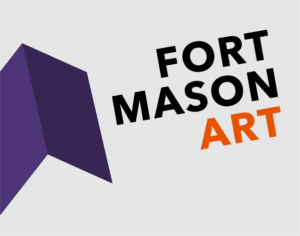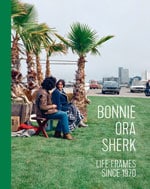Bonnie Ora Sherk: Life Frames Since 1970
FORT MASON CENTER FOR ARTS & CULTURE (FMCAC):
JANUARY 13, 2024 TO MARCH 10, 2024
AVAILABLE TO TOUR JANUARY 2025
Fort Mason Art presents Bonnie Ora Sherk: Life Frames Since 1970, the first survey exhibition of the late artist, environmental educator, and landscape planner. Before urban farms reclaimed unused city parcels, before parklets popped up across urban street scapes, before New York City’s High Line and the San Francisco Presidio’s Tunnel Tops repurposed stretches of railway and highway into green spaces – there was the groundbreaking work of Bonnie Ora Sherk (1945-2021).
Decades ahead of her time, Sherk’s pioneering projects in 1970s San Francisco, including Portable Parks I-III (1970, with Howard Levine) and Crossroads Community (the farm), conceptualized new uses for overlooked urban landscapes, and laid the foundation for a global movement to reclaim urban spaces.
Bonnie Ora Sherk: Life Frames Since 1970 presents newly transferred film and video as well as rarely seen photographs, collages, works on paper, artist books, printed matter, and ephemera of Sherk’s early performances and site-specific interventions in the 1970s and 1980s. Sherk’s expansive artistic vision for transforming urban landscapes through A Living Library (1981-present) is explored through a selection of proposals and drawings since the 1980s.
Bonnie Ora Sherk: Life Frames Since 1970 Exhibition Catalog
FMCAC produced the first significant catalog dedicated to the artist. Designed by McCall Associates, the fully illustrated publication features key historic interviews (Linda Frye Burnham and Linda M. Montano) and writings by Sherk with text by co-editors FMCAC Director of Arts Programming & Partnerships Frank Smigiel and exhibition curator Tanya Zimbardo, and guest authors (John Bela, Jane Blankenship, Robert Croonquist, Karen Moss, Jen Delos Reyes, Ryan David Tacata, and Patricia Watts).
Bonnie Ora Sherk: Life Frames Since 1970 Catalog
$40.00
Curated by Tanya Zimbardo, Bonnie Ora Sherk: Life Frames Since 1970 traces the development of Sherk’s commitment to art and ecology in the public sphere over a range of projects. Sherk is recognized as a key figure among the first generation of Conceptual Art and performance artists in California and the alternative or artist-run space movement of that era.
Her solo performances and installations in the 1970s – such as Snow Job (1970) in front of the San Francisco Museum of Art (now SFMOMA), Public Lunch (1971) at the San Francisco Zoo, and Living in the Forest: Demonstration of Atkin Logic, Balance, Compromise, Devotion, etc. (1973), in the de Saisset Museum at Santa Clara University – re-imagined ecosystems: a mound of snow appears in San Francisco; the artist eats lunch next to tigers; animal habitats take root in an art gallery. These early works show the artist’s lifelong study of the interrelationships between plants, animals, and humans, with the goal of creating sustainable systems for social and ecological transformation.
“Before her passing, Sherk enjoyed a resurgence of interest in her pioneering work in the public sphere and its legacy for contemporary art, from ecofeminism to social practice,” said Tanya Zimbardo, guest curator. “It is an honor to be able to offer an in-depth look at the evolution of her ideas, which resonate with a range of community gardening, food justice, and environmental sustainability initiatives today in the Bay Area.”
“Around the world, there is a movement underway to transform urban spaces like parking spaces, freeway on-ramps, and streets themselves into gathering places,” said Mike Buhler, President and CEO of FMCAC. “The seeds of that movement are rooted in Bonnie’s work here in San Francisco.”
Sherk’s first public installation, Portable Parks I-III (1970, with Howard Levine), transformed a series of urban “dead spaces” in San Francisco – the former James Lick Freeway that crossed over Market Street; two concrete islands adjacent to the Mission/Van Ness Off ramp; the whole street of Maiden Lane between Stockton and Grant – into green, living environments, complete with sod, palm trees, and live animals. The temporary installations would go on not only to win critical acclaim but would presage the pop-up urbanism movement decades later.
Considered Sherk’s best-known project, The Farm, was a multi-arts center, environmental education farm, and community gathering place located underneath a major freeway interchange in San Francisco at the former location of a dairy farm. Working to unite parcels of land across four neighborhoods bisected by the freeway, The Farm engaged multigenerational neighbors and school children from across the city while playing host to visual, performing arts, and music communities until 1987. Inspired by Sherk’s work, San Francisco ultimately transformed the site into a permanent park, Potrero del Sol.
For the exhibition, the collaborative spirit of Sherk’s era as founding president of The Farm from 1974 to 1980 were pictured through video, photography, and posters spanning hands-on activities to circus and dance performances.
“Bonnie is the rare artist whose contributions extend beyond her medium of choice and into the physical fabric of our urban environment,” said Frank Smigiel, Director of Arts Programming and Partnerships for FMCAC.
Today, Sherk’s bicoastal nonprofit A Living Library (ALL), established in 1981, continues her vision for community-oriented, environmental projects located on Roosevelt Island, NYC, and the Bernal Heights, and OMI/Excelsior neighborhoods in San Francisco. ALL brings community members and youth together to restore native habitats, create educational gardens, plant trees, and daylight San Francisco’s Islais Creek watershed.
===================================
About the Artist: Bonnie Ora Sherk (American, born 1945, New Bedford, MA – died 2021, San Francisco) was a visionary, internationally recognized American artist, landscape architect, and environmental educator. Sherk founded The Farm, situated under a freeway interchange in San Francisco, which she directed from 1974 to 1980. In 1981, Sherk founded Life Frames, Inc., supporting her nonprofit educational work A Living Library (ALL). Currently, active locations of ALL projects are on Roosevelt Island, NYC (2001-present), and in San Francisco at the Bernal Heights Living Library & Think Park Nature Walk (2002-present) and OMI/Excelsior Living Library & Think Park (1998-present).
Sherk’s multidisciplinary work explored the interdependent relationships between humans, animals, and nature. She lectured and exhibited across the globe, with installations featured in the Venice Biennale 2017 and the Liverpool Biennial 2021. Other major group shows include Territories That Matter: Art, Gender And Ecology, Centro de Arte y Naturaleza-Fundación Beulas (CDAN) (Huesca, Spain; 2019); Unsettled, Nevada Museum of Art (Reno, NV; 2017); Hippie Modernism: The Struggle for Utopia, Walker Art Center (Minneapolis, MN; 2015); Museum of Arte Útil, Van Abbemuseum (Eindhoven, NL; 2014); Feast: Radical Hospitality in Contemporary Art, Smart Museum of Art (Chicago; 2012); State of Mind: New California Art circa 1970, Berkeley Art Museum and Pacific Film archive (BAM/PFA) (Berkeley, CA; 2011); Under the Big Black Sun: California Art 1974-1981, Museum of Contemporary Art (MOCA) (Los Angeles, 2011); and WACK! Art and the Feminist Revolution, MOCA (Los Angeles, 2007), among many others.
Sherk received a BA in Art from Rutgers University’s Douglass College, an MA in Environmental Sculpture from San Francisco State University, and certifications in Landscape Architecture from the University of California at Berkeley, CA and Oomoto School of Traditional Japanese Arts in Kameoka, Japan. She lived and worked in San Francisco and New York City.
About the Curator: Tanya Zimbardo is a contemporary art curator based in San Francisco. As an assistant curator of media arts at the San Francisco Museum of Modern Art, she has curated solo exhibitions of work by Jim Campbell, Runa Islam, Pat O’Neill, and Kerry Tribe, as well as the two-person and group exhibitions Speculative Portraits Future Histories: Theaster Gates and Cauleen Smith; Soundtracks; Ragnar Kjartansson: The Visitors; and Susan Philipsz: Songs Sung in the First Person on Themes of Longing, Sympathy, and Release, are currently on view at SFMOMA. Zimbardo featured Sherk in group exhibitions she co-curated at SFMOMA (Fifty Years of Bay Area Art: The SECA Awards) and at Mills College Art Museum (Public Works: Artists’ Interventions 1970s – Now). Over the past decade, Zimbardo has featured artists associated with Bay Area Conceptual art, performance, and experimental media in exhibitions and screenings at nonprofit art venues including di Rosa Center for Contemporary Art (Equilibrium: A Paul Kos Survey) and The 500 Capp Street Foundation (Organic Logic).
IMAGES —
Numbers 1: Sitting Still 1, 1970
Numbers 2, 3, 5, and 6: Photos by Charlie Villyard
Number 4: Photo by Minoosh Zomorodinia
Number 5: Portable Park II (with Howard Levine), 1970
Number 6: A Living Library Promotes Sustainable Development And Health By Cultivating The Human & Ecological Garden poster, 2013
Number 7: Collage from A Living Library Bryant Park proposal, 1983
Number 8: Sitting Still Series, Golden Gate Bridge, 1970
FMCAC Exhibition Details:
On view: January 13, 2024 through March 10, 2024
Open: Wednesday through Saturday, 12:00 p.m. (noon) to 6:00 p.m.; Sunday, 11:00 a.m. to 5:00 p.m.
Gallery 308, Landmark Building A
Free Admission
On the occasion of Sherk’s exhibition, FMCAC commissioned a pop-up community garden developed by John Bela, an urbanist, co-founder of Rebar, and co-creator of the modern parklet, in tribute to the artist’s Portable Parks.
“Bonnie’s performative installations laid the groundwork for parklets as an expression of community in green spaces on our city streets,” said Bela. “There is a direct through line from her work in the 1970s to the parklets of today.”
John Bela‘s temporary Garden To Transform Hatred Into Love, was installed outdoors on the patio adjacent to Gallery 308. Local urban farmers Urban Campesinx / Hummingbird Farm conducted free Sunday Workshops in conjunction with the exhibition.
Fort Mason Art also presented a free closing weekend symposium on Saturday, March 9, 2024 (Gateway Pavilion) featuring discussions surrounding Sherk’s relationship to landscape, expanding forms, pedagogy, artist-led spaces, and communities around her Crossroads Community (the farm). The event culminated with a reception launching the publication for the exhibition.
Bonnie Ora Sherk: Life Frames Since 1970 was part of FMCAC’s signature Gallery 308 exhibition series presenting leading contemporary artists, including Sophie Calle, Janet Cardiff, Joan Jonas, Sir Isaac Julien, and Sunny A. Smith.


